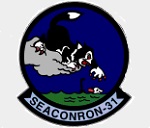Hobby Master HA4903 US Navy Lockheed S-3A Viking Anti-Submarine Aircraft - 159769, VS-31 "Topcats", USS Independence (CV-62), 1972 (1:72 Scale)
"The S-3 was a unique program. We went from first contract to first contact over a submarine in just three years."
- Lockheed Executive Vice President Tom Burbage, who flew the Viking as a Navy test pilot and later ran the S-3 program for the company
 The Navy began what became the S-3 Viking program in 1964 to replace the piston-powered S-2 Tracker. Known originally as VSX - for "carrier-based antisubmarine warfare aircraft-X" - a formal request for proposal was issued in April 1968. A joint General Dynamics-Grumman team and the then-Lockheed Aircraft Corp. were chosen from among the competitors to refine their proposals.
The Navy began what became the S-3 Viking program in 1964 to replace the piston-powered S-2 Tracker. Known originally as VSX - for "carrier-based antisubmarine warfare aircraft-X" - a formal request for proposal was issued in April 1968. A joint General Dynamics-Grumman team and the then-Lockheed Aircraft Corp. were chosen from among the competitors to refine their proposals.
Although Lockheed had four decades of land-based antisubmarine warfare experience dating back to the World War II-era Hudson, the company had only built one carrier-based aircraft to that point, the T2V-1 SeaStar trainer. To build a strong Navy-oriented team, Lockheed first brought on LTV Aerospace, formerly Vought, with its long history in carrier aviation, as a partner. Then the Federal Systems Division of Sperry Rand was added to develop the aircraft's computerized acoustic detection system, a first for an airborne antisubmarine warfare platform.
The Lockheed team was declared the winner of the VSX competition on August 4th, 1969. One of several speakers at the 2009 retirement ceremony was current Lockheed Martin F-35 Executive Vice President Tom Burbage, who flew the Viking as a Navy test pilot and later ran the S-3 program for the company. He noted that "the S-3 was a unique program. We went from first contract to first contact over a submarine in just three years."
Pictured here is a 1:72 scale replica of a US Navy Lockheed S-3A Viking anti-submarine aircraft that was attached to VS-31 "Topcats", then embarked upon the USS Independence (CV-62), during 1972.
Sold Out!
Dimensions:
Wingspan: 9-inches
Length: 11-1/2-inches
Release Date: September 2016
 Historical Account: "Topcats" - Sea Control Squadron 31 (VS-31) Topcats was a United States Navy anti-submarine warfare squadron, active during World War II, and later re-established in 1948, serving until 2008.
Historical Account: "Topcats" - Sea Control Squadron 31 (VS-31) Topcats was a United States Navy anti-submarine warfare squadron, active during World War II, and later re-established in 1948, serving until 2008.
It was founded as Scouting Squadron 31 in 1942, based at Naval Air Station Squantum, Massachusetts. It flew the dive bombers Douglas SBD-5 Dauntless, then the Curtiss SB2C-4E Helldiver in the North Atlantic until decommissioned at the end of the war in 1945.
The squadron was recommissioned as Composite Squadron VC-31 in April 1948 at NAS Atlantic City, New Jersey, and was re-designated Air Anti-Submarine Squadron 31 (VS-31) the following year and moved to NAS Quonset Point, Rhode Island. Originally flying the Grumman TBF Avenger, these were later replaced by the Grumman AF Guardian and the Grumman S-2 Tracker in 1954, and finally by the Lockheed S-3 Viking. In 1973, VS-31 was relocated to NAS Cecil Field, Florida, and eventually to NAS Jacksonville. On October 1st, 1993, the squadron was re-designated Sea Control Squadron VS-31. It was finally deactivated at NAS Jacksonville on March 27th, 2008.









